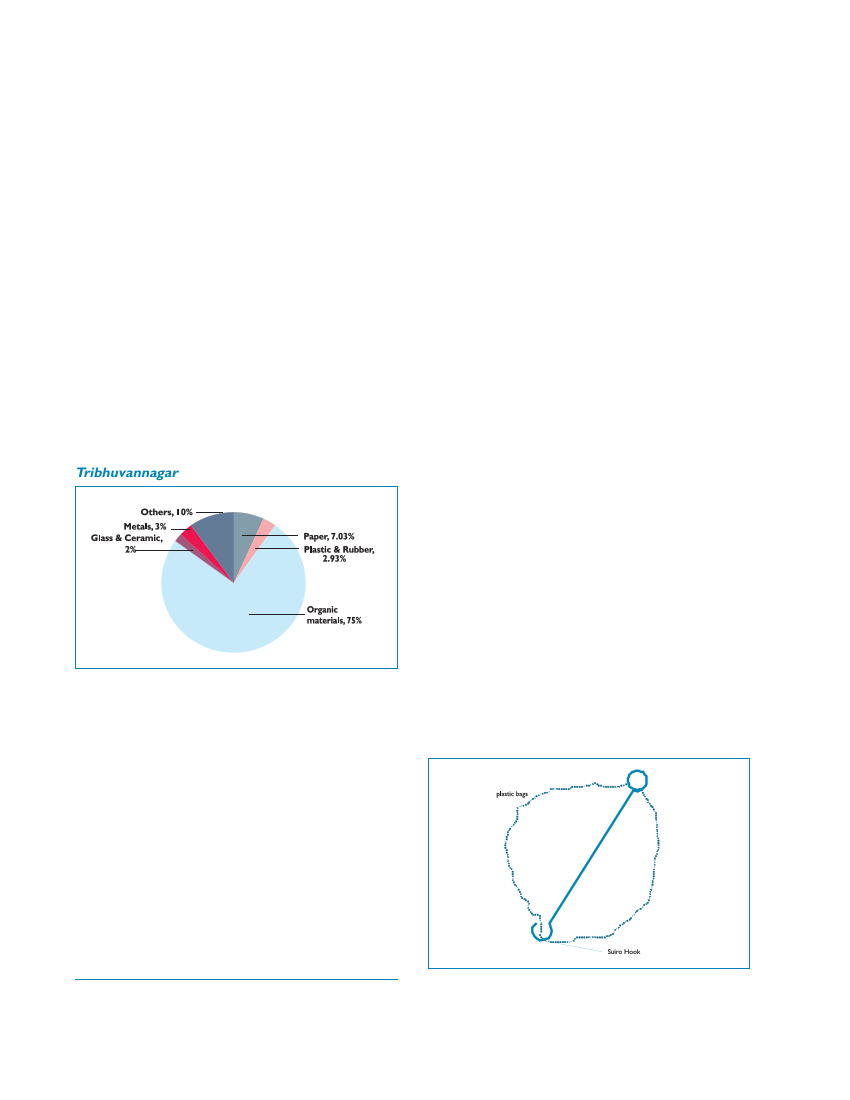
BEST PRACTICES ON SOLID WASTE MANAGEMENT OF NEPALESE CITIES
Kathmandu - 0.39kg/capita/day (SWMRMC, 2008 data).
The total waste generation is estimated to be 14 tons/
day (Tribhuvannagar municipality, 2008 data).
Unofficial data show that most of the solid waste comes
from households, and that 3 to 4 tons/day come from
commercial and industrial premises (Tribhuvannagar
municipality, 2008 data. The composition of solid waste
at source is paper 7.03 per cent, plastic & rubber 2.93
per cent, organic 75.04 per cent, glass and ceramics
2.00 per cent, metal 3.00 per cent and other materials
10.00 per cent (Tribhuvannagar municipality, 2008
data). One government hospital housing 50 beds is
situated inside the municipal area. According to UN-
HABITAT Nepal, the waste generation rate for hospital
waste in Nepal is 1.72 kg/day/bed (UN-HABITAT, KMC
data, 2007) and therefore the estimated daily generation
of hospital waste is 86 kg/day.
Chart 2: Composition of solid waste at source in
Tribhuvannagar municipality
and two rickshaws that can each carry up to 500 kg
are used for primary waste collection (Tribhuvannagar
municipality, 2008 data).
Daily collection is provided for 50 per cent of the urban
population, including the commercial areas. Waste
collectors from the municipality use a thick textile sheet
to load the solid waste into the compactor truck. One
compactor of capacity six tons and one tractor and trailer
that can carry two tons are used for waste collection in
different sections of the city, taking the waste to the landfill
(Tribhuvannagar municipality, 2008 data). (The
photographs at the end of this section show the collection
and disposal system.) At the landfill site, municipal
labourers separate the biodegradable waste and tip it
into trenches for composting. It is estimated that the
recycling rate for domestic and commercial waste is 15-
20 per cent (Tribhuvannagar municipality, 2008 data).
Compost from the landfill site is sold for NRs.300 per
10cu.ft (280 litres) load. Plastic and rubber are sold for
NRs.13/kg (Tribhuvannagar municipality, 2008 data).
During the field survey, it was noted that the
Municipality was planning to launch a programme to
encourage household composting and the use of Suiro14
hooks in order to encourage at-source segregation of
recyclable wastes. A Suiro hook can be used to hold a
bunch of used plastic bags together before they are
collected for recycling. This is shown in the photos for
the section 2.1 concerning Bharatpur.
The solid waste
management system
After the implementation of the SWM programme,
Tribhuvannagar municipality has been working
seriously towards effective waste collection and
transport, waste separation and landfilling operations.
Waste is collected from various unofficial collection
points A total of 50 metal-framed plastic bins (capacity
50 kg) which are placed in different parts of the city for
regular collection. Such bins are also distributed to
local TLOs13 for weekly collection. Residents put their
mixed waste out for collection in plastic bags and than
dump it at various unofficial collection points or in the
storage bins. Eight handcarts that can each carry 50 kg
Final disposal
The landfill site used by Tribhuvannagar municipality
is owned by the municipal government and is located
13 TLO (Tole Lane Organisation) is community-based organization
established by UNDP and the Municipality. The area concerned may comprise only one or two streets.
14 Sharpened wire hook used for storing recovered plastics.
10